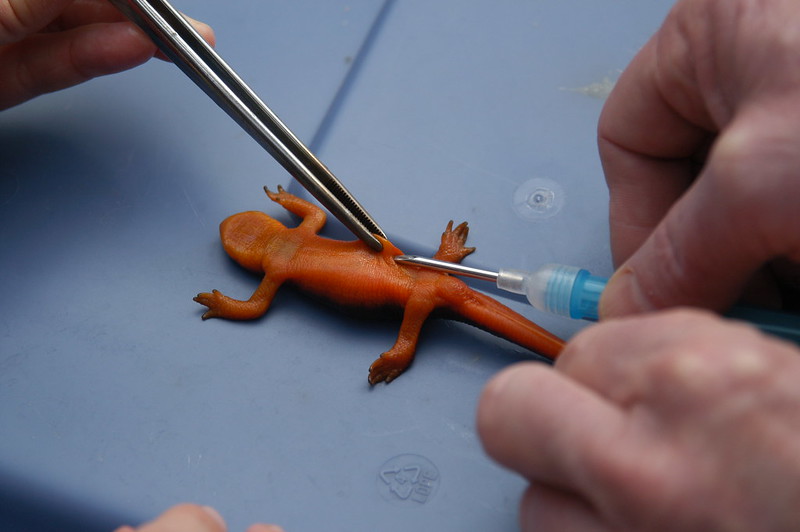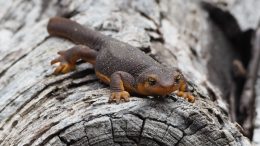Aerial photos of the Sierra Nevada — the long mountain range stretching down the spine of California — showed rust-colored swathes following the state’s record-breaking five-year drought that ended in 2016. The 100 million dead trees were one of the most visible examples of the ecological toll the drought had wrought.
Now, a few years later, we’re starting to learn about how smaller, less noticeable species were affected.
One of those is the California newt (Taricha torosa). These large, colorful amphibians live across the state, from Mendocino County to San Diego County, but newts living in Southern California fared worse during the drought, according to a new study published in the Nature journal Scientific Reports. And worse, anticipated future changes to the climate are likely to put northern newts in the same boat in coming decades.
Researchers have been surveying populations of these amphibians for decades. By tagging them with transponders and following their movements, they’ve learned that the newts can live for more than 30 years and return to the same spots year after year as they migrate between freshwater and land.
But as the drought began in 2012, the researchers noticed a change in the Southern Californian populations. There were fewer newts from the tagged population coming back to dozens of breeding sites monitored across the region each year. The researchers also observed fewer egg masses, tadpoles and larvae.
“Here’s a long-lived species that we’re not seeing individuals that we’ve seen for the last 10 or 15 years coming back to the sites where they usually breed,” says Gary Bucciarelli, the lead author of the report and an assistant adjunct professor of ecology and evolutionary biology at UCLA.
And there was one more piece of bad news: Most of the adult newts that did return in Southern California were in poorer body condition than before the drought began. This negative trend, the researchers concluded, was linked to drier and warmer conditions that were far outside the 100-year average.
At the time the state was experiencing drought conditions not seen there for 1,200 years. You’d expect drought to hurt amphibians, which rely on access to water, but Bucciarelli says the research shows that similarly record-high air temperatures may have played an even greater role than precipitation.
Warmer temperatures remove necessary moisture from the terrestrial environment. But they could also affect food — a shifting climate may mean less prey, says Bucciarelli. Or it could mean that newts spend more time wandering around, burning calories, and less time hunkered down as they normally would.
Whatever exactly happened in this case, “It all was strongly correlated with the extreme deviation in climate,” he adds.

Amphibians spend part of the year on land, and we know far less about how they spend their terrestrial days. “When they’re on land we don’t know if they’re underground, moving around, in a deep sleep, or what they’re feeding on,” he says. “This research suggests there are things happening on land that are impacted by temperature that we don’t really understand.”
One thing is certain, though: Climate change will bring more severe droughts and higher temperatures to California, and that could push newts in Southern California, which are already a species of conservation concern, closer to extinction.
And in the next 50 years, the northern populations are likely to experience the same change in body condition. That means that the northern range “likely will not provide climate refuge for numerous amphibian communities,” the researchers conclude.
That’s particularly bad news considering that globally, an estimated 40% of amphibians face extinction. A disease caused by chytrid fungus has devastated many amphibian populations, especially in Australia, Central and South America, and wiped out 90 species already.
But amphibians face other threats, too. And the California newt is no exception.
The species is adapted to drought, but “they haven’t dealt with drought coupled with temperature changes that are this rapid and this severe, in conjunction with habitat fragmentation, land use changes and fire frequency changes,” Bucciarelli says. “Now we’re beginning to see how these combined stressors are acting out ecologically.”
So what do we do?
Collecting more data is a good start. Land managers need to begin long-term monitoring surveys of populations of amphibians now, even if the species aren’t currently a major concern. “You never know what’s going to happen and having baseline data is super important,” he says.
Proactively improving habitat is also critical. We can start by ensuring that habitats are free of non-native species, says Bucciarelli, who has also tracked the negative effects of introduced fish and invasive crayfish on amphibians.
Suitable habitat is key, but so is connection. Many newt populations in Southern California have become islands, separated by development that limits their genetic diversity — and in the long run, their capacity to adapt to rapidly changing environmental conditions. Ensuring habitat connectivity could help strengthen their resilience.
Even if all of that happens, climate change will continue to be a threat, and Bucciarelli says we may need to develop contingency plans for worsening conditions if we hope to save these newts.
“We’ll have to think of different and more creative management strategies to help in years when temperature and precipitation are not in line with the norm.”
![]()


